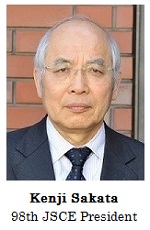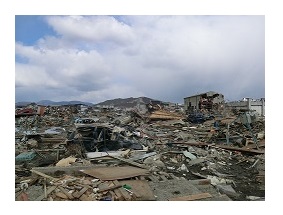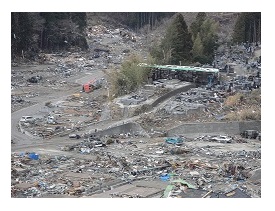IAC News
IAC News Extra.3, Oct 31,2013
Japan Society of Civil Engineers International Activities Center Oct 31, 2013 IAC News Extra.3
IAC News Special issue
Lessons Learned from the Great East Japan Earthquake
 Born in 1943. Graduate of Kyoto University. Served as professor at Okayama University; chaired the Faculty of Environmental Science and Technology and the Graduate School of Natural Science and Technology; now Professor Emeritus. Served as president of the Japan Society of Dam Engineers, the Japan Concrete Institute, and JSCE. Received the JSCE Outstanding Paper Award, Yoshida Award (Outstanding Paper Division and Research Accomplishment Division), and other honors.
Born in 1943. Graduate of Kyoto University. Served as professor at Okayama University; chaired the Faculty of Environmental Science and Technology and the Graduate School of Natural Science and Technology; now Professor Emeritus. Served as president of the Japan Society of Dam Engineers, the Japan Concrete Institute, and JSCE. Received the JSCE Outstanding Paper Award, Yoshida Award (Outstanding Paper Division and Research Accomplishment Division), and other honors.
Nearly two years have passed since the Great East Japan Earthquake. That earthquake of magnitude 9.0 and seismic intensity 7 was the largest ever recorded in Japan. The tsunami, much higher than 10 meters, has left catastrophic damage along the Pacific coast from the Tohoku region to the Kanto region, and an accident at the Fukushima Daiichi Nuclear Power Plant of Tokyo Electric Power Co. caused a nuclear disaster as well. Many residents were driven from their communities and are still living as evacuees all over Japan. Immediately following the disaster, the violence of the tsunami's attack on the seaside towns of the Sanriku Coast and the unbecoming stillness of the devastated communities were inexpressible. There was too great a gap between the realities we saw before our eyes and the power of words to describe them. We could only remain silent in those days.
Preparing for the unexpected
 Protecting people from natural disasters is an important part of the job of a civil engineer, and we have learned a great deal from the Great East Japan Earthquake. This disaster has tested the appropriateness and effectiveness of the technical measures and systems that we have developed on the basis of many disasters that were experienced in the past. It has also brought up new issues for us to resolve. To sum up the lessons that I myself have learned in a nutshell, it is necessary to prepare for the unexpected, because past disasters will be surpassed by future disasters. We have learned the lesson that without a doubt, disasters that we cannot predict or anticipate will occur at times.
Protecting people from natural disasters is an important part of the job of a civil engineer, and we have learned a great deal from the Great East Japan Earthquake. This disaster has tested the appropriateness and effectiveness of the technical measures and systems that we have developed on the basis of many disasters that were experienced in the past. It has also brought up new issues for us to resolve. To sum up the lessons that I myself have learned in a nutshell, it is necessary to prepare for the unexpected, because past disasters will be surpassed by future disasters. We have learned the lesson that without a doubt, disasters that we cannot predict or anticipate will occur at times.
The Great East Japan Earthquake surpassed the 1995 Hanshin-Awaji (Kobe) Earthquake. The conditions of this disaster made it different from any previous disaster, including not only the strength of the earthquake and flood height of the tsunami, but also the extensive size of the affected region, the presence of completely devastated areas, and the nuclear accident. The Ise-wan Typhoon which struck Japan in 1959 was a massive disaster, resulting in more than 5,000 fatalities and missing persons. Exactly 50 years later, in 2009, Typhoon No. 18 followed practically the same course as the Ise-wan Typhoon and was basically the same in size, but its effects were quite minor in comparison to the damage caused by the Ise-wan Typhoon. That was the result of dams and river embankments that had been constructed over the past 50 years. It then appeared that we had overcome disasters of that type. However, Japan suffered flooding of an unprecedented scale last year, with contributing factors including the growing scale of typhoons due to climate change caused by global warming, back-building thunderstorms due to stationary seasonal rain fronts, and the extraordinarily heavy downpours that have occurred as a result.
Disaster mitigation
 Preparing for the unexpected includes the concepts of developing fail-safe designs, preparing countermeasures for severe accidents at nuclear power plants, and minimizing residual risk. After the Great East Japan Earthquake, our attention was drawn to the concept of disaster mitigation. This refers to preparing for unexpected disasters with the top priority of preventing the loss of human lives when disasters strike, while minimizing economic losses as well. Based on the experiences of the Hanshin-Awaji Earthquake, changes have been made in earthquake resistant design and aseismic reinforcement with the goals of preventing the loss of human lives and limiting the extent of damage so that restoration can be accomplished within a short period of time, even when structures reflecting these new measures are damaged by enormous external forces. In other words, the goal is fail-safe design
Preparing for the unexpected includes the concepts of developing fail-safe designs, preparing countermeasures for severe accidents at nuclear power plants, and minimizing residual risk. After the Great East Japan Earthquake, our attention was drawn to the concept of disaster mitigation. This refers to preparing for unexpected disasters with the top priority of preventing the loss of human lives when disasters strike, while minimizing economic losses as well. Based on the experiences of the Hanshin-Awaji Earthquake, changes have been made in earthquake resistant design and aseismic reinforcement with the goals of preventing the loss of human lives and limiting the extent of damage so that restoration can be accomplished within a short period of time, even when structures reflecting these new measures are damaged by enormous external forces. In other words, the goal is fail-safe design
However, it is not an easy matter to establish specific civil engineering technologies and social systems for the realization of disaster mitigation. A variety of proposals have been put forward that call in very simplistic terms for a general mobilization of "hardware" and "software" measures, but a great deal of hard work in research and technological development will be required for this to become a reality. Since Japan experiences a particularly large number of natural disasters, disaster mitigation efforts must include earthquakes, tsunamis, volcanic eruptions, flooding due to heavy downpours, heavy snowfall, and nuclear accidents. To make "software" measures effective, it is important to provide evacuation drills and suitable disaster education led by experts in schools and communities. It is also essential to develop the necessary "hardware" to secure the "software" measures, including the establishment of evacuation buildings and evacuation sites as well as ensuring evacuation routes that lead to those places. Especially in coastal communities outside large cities, it is desirable to establish "software" measures to cope with isolation and the needs of the elderly.
Let's take a look at the state of the energy policy debate in Japan, following the experience of the worst nuclear power accident. A new administration was established with the lower house election in late 2012. The political parties have made various pledges such as eliminating the use of nuclear power or reducing the country's dependence on nuclear power, but as of the time of this writing, it is still unclear what direction the government will take. Considering the energy problems that Japan will face in the future, the development of renewable energies is an urgent task. It is also important to pursue the redevelopment of dams in preparation for unprecedented flooding caused by climate change due to global warming, as well as the restoration of hydroelectric power as a clean source of energy.
Preparing for a massive Nankai trough earthquake
In March 2012, the Committee for Modeling a Nankai Trough Megaquake, established under the Central Disaster Management Council of the Cabinet Office, issued new predictions concerning a massive earthquake that is expected to occur along the Nankai Trough with an associated tsunami. Based on scientific research and the lessons learned from the Great East Japan Earthquake 2011 and the massive tsunami that accompanied it, the new prediction model indicates the maximum class of earthquake and tsunami that is anticipated, taking all possibilities into consideration. According to this model, an earthquake of magnitude 9.1 and seismic intensity 7 could strike 10 prefectures and 153 municipalities, causing a tsunami more than 20 meters in height that would threaten 23 municipalities. This is expected to be a massive disaster that will surpass the Great East Japan Earthquake.
In a recent legal decision concerning earthquake predictions for the April 2009 L'Aquila Earthquake in central Italy, seven persons, including earthquake scientists and a government official, were sentenced to six years in prison for negligence resulting in death on the grounds that the government's declaration of safety had the result of magnifying the damage. It is not possible here to debate whether this decision was justified; however, the issue that it brings into question is not the accuracy of earthquake prediction but the approach to providing disaster information.
The Japanese government has issued predictions concerning a Nankai Trough Earthquake, and it should continue to provide expert information, including the limits of prediction, in order to encourage the general public to have a proper level of concern and make preparations on their own, as well as to enable the municipalities in question to implement appropriate measures. There is concern that if figures such as a tsunami height of 34 meters and seismic intensity of 7 are tossed around without the proper context, the effect may be to actually discourage people from taking suitable actions for disaster prevention and developing measures for disaster mitigation.
Meanwhile, there is concern that memories of the Great East Japan Earthquake will fade with the passing of time. To prepare for a massive earthquake and tsunami along the Nankai Trough, it is necessary to compile a thorough account, with an expanded scope ranging from the government's response to the experiences of individual disaster victims, in order to describe and analyze what happened in the Great East Japan Earthquake, what lessons became clear, and what inadequacies were revealed. If this task is not completed, it will not be possible to prepare properly for the next large-scale disaster.
The tasks set before us are many, including reconstruction after the Great East Japan Earthquake, preparations for another massive earthquake that is expected to strike, development of infrastructure for adaptation to global warming, and steps to upgrade deteriorated infrastructure.
(This is an English translations from the Japanese version published in JSCE Journal, Vol. 98, No. 3, March 2013)
What's Happening
●Nov 7-9:39th PICE National Convention (2013), (Davao, Philippines)
●Nov 8-9:Symposium of 40th Year Celebration of Diplomatic Relationship Japan between Vietnam
(Hanoi, Vietnam)
●Nov 22:2013 CICHE Annual Meeting (Taipei, Taiwan)
●Nov 28:Joint Seminar of PICE and JSCE-Philippines: Civil Engineering Responses to Environmental
Issues (UP-Diliman- National Center for Transportation Studies, Manila, Philippines)
Updates
・The summary of feature articles in the JSCE Magazine is available on the JSCE website.
(http://www.jsce-int.org/pub/magazine)
・Concrete Committee International Newsletter No. 34
(http://www.jsce.or.jp/committee/concrete/e/newsletter/newsletter32/index.htm)
IAC News Subscription
IAC publishes the IAC News as one of tool to communicate with and share information with the members. In order to network widely, we would like to invite you, your friends and colleagues to become a subscriber to the IAC News. Please register online if you are interested in the IAC News: (http://committees.jsce.or.jp/s_iad/iac_news_e). We are looking forward to meeting you.
Registration form for IAC News subscription:
・Japanese :(http://committees.jsce.or.jp/kokusai/node/31)
・English :(http://www.jsce-int.org/pub/registration/non-international_students)
・English for those who have studied/ graduated from Japanese colleges and universities :
(http://committees.jsce.or.jp/kokusai/node/30)
【Comments and Questions】
Please send us your feedback and comments to help us improve the IAC news. We look forward to hearing from you.
JSCE IAC: iac-news@jsce.or.jp
